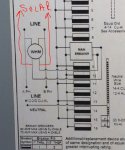- Location
- Simi Valley, CA
The utility did not allow a load side tap previously, so it has never been an issue, but they have since changed their opinion.
My questions are, do I treat this like a feeder tap and size it per 240.21 or is it a branch circuit and install it per 210.19 & 210.20 or do I use 705.12? And what does the last part of 705.12(A) mean?
My questions are, do I treat this like a feeder tap and size it per 240.21 or is it a branch circuit and install it per 210.19 & 210.20 or do I use 705.12? And what does the last part of 705.12(A) mean?


